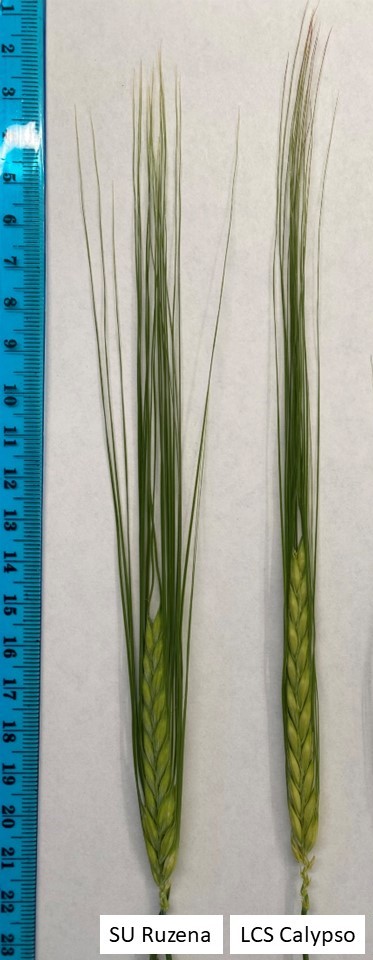SU Ruzena
| Denomination: | 'SU Ruzena' |
|---|---|
| Botanical Name: | Hordeum vulgare |
| Applicant/Holder: |
Ackermann Saatzucht GmbH & Co. KG Marienhofstra▀e 13 Irlbach D-94342 Germany |
| Breeder: |
Ackermann Saatzucht GmbH & Co. KG, Irlbach, Germany |
| Agent in Canada: |
SeCan Association 400-300 Terry Fox Drive Kanata, Ontario K2K 0E3 Canada Tel: 613-592-8600 ext.223 |
| Application Date: | 2020-09-14 |
| Provisional Protection:: | 2020-09-14 |
| Application Number: | 20-10348 |
| Grant of Rights Date: | 2023-05-08 |
| Certificate Number: | 6821 |
| Grant of Rights Termination Date: | 2043-05-08 |
Variety Description
Variety used for comparison: 'LCS Calypso'
Summary: 'SU Ruzena' has a shorter spike, excluding the awns, than the spike of 'LCS Calypso'.
Description:
PLANT: two row, winter feed barley, absent or very low to low frequency of plants with recurved flag leaves
YOUNG PLANT: intermediate growth habit at tillering, sparse pubescence on lower leaf sheaths
FLAG LEAF BLADE (AT BOOTING): sparse pubescence
FLAG LEAF SHEATH: strong to very strong glaucosity, sparse pubescence
AURICLES: no anthocyanin colouration
SPIKE: early emergence, weak to medium glaucosity at end of anthesis, horizontal to semi-nodding attitude, cup shaped collar, parallel shape, lax, sterile spikelet divergent attitude,
LEMMA AWNS: very weak intensity of anthocyanin colouration of tips, longer than length of spike, rough spiculations on margins
KERNEL: whitish aleurone layer, husk present, long rachilla hairs, hairiness of ventral furrow absent
Origin & Breeding History: 'SU Ruzena' (experimental designation AC09/274/10) originated from a cross between the varieties 'California' and 'Metaxa' made in the county of Straubing, Bavaria, Germany in 2009. A double haploid breeding method was used in the development of the variety. Selection criteria were based on disease and lodging resistance, and maturity. The breeder seed was established using 50 single plant selections in 2013.
Tests & Trials: The comparative trials for 'SU Ruzena' were conducted in West Montrose, Ontario during the 2021 and 2022 growing seasons. These winter varieties were sown in the fall of 2020 and 2021, respectively. The trials were arranged in a RCB design with 4 replicates per variety. Each plot consisted of 6 rows, 5.5 metres in length and spaced 19 cm apart. The seeding density was 307 seeds per metre squared resulting in approximately 1900 plants per variety per year. Measured characteristics were based on a minimum of 20 measurements per variety per year. Mean differences were significant at the 5% probability level based on LSD values.
Comparison table for 'SU Ruzena' with reference variety 'LCS Calypso'
Spike length (excluding awns)(mm)
| 'SU Ruzena' | 'LCS Calypso' | |
|---|---|---|
| mean 2020/21 (LSD=2.7) | 72.7 | 78.9 |
| std. deviation 2020 | 8 | 8 |
| mean 2021/22 (LSD=4.3) | 55.9 | 72.7 |
| std. deviation 2021 | 6 | 7 |
Click on image for larger view

Barley: 'SU Ruzena' (left) with reference variety 'LCS Calypso' (right)
- Date modified: